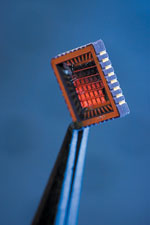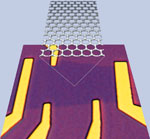Computer Researchers Look Past Silicon
 |
| Researchers at the University of Delaware have fabricated spin-transport silicon devices on a single ceramic chip. Spintronics is one of the technologies that may serve as the successor to conventional complementary metal oxide semiconductors (CMOS) when silicon no longer can serve as the leading edge in processor technology. |
Scientists are racing against the clock to develop a means of defeating an enemy that threatens to stop computer technology progress dead in its tracks. The threat is not terrorism; it is
Many computer experts have been predicting since the last millennium that the technology underpinning the information revolution was nearing the end of its progressive development. Scientists have been able to prove those earlier prognostications wrong as silicon chip density and power continued to increase geometrically. Now, however, researchers are seeing the beginning of the end as physical limitations are becoming evident. Within 10 to 15 years, some experts say, the doubling of computing power every 18 to 24 months with complementary metal oxide semiconductor (CMOS) chips will come to an end.
Instead of trying to fight nature, scientists are exploring new materials and techniques that could be exploited to produce new generations of processing chips. No clear contender as an heir to silicon has emerged yet, as researchers must consider scalability, fabrication and economics in their quest to find the next type of microprocessor.
This may involve changing the nature of the processor itself. Existing CMOS devices feature thousands or millions of charge-based transistor switches on a single chip. Future devices may incorporate spin-based, optical or molecular switches.
But none of these technologies is likely to pan out in the near future, warns Shankar Basu of the National Science Foundation (NSF). These are long-term research projects, says Basu, program director, Computing and Communication Foundations (CCF) division, Computer and Information Science and Engineering (CISE) directorate at NSF. He points out that the computing industry cannot wait for these blue-sky technologies to become economically viable, so near-term research aims to exploit CMOS technology by enhancing its products.
One near-term fix may be multicore chips. Describing it as a band-aid solution to the problem, Basu nevertheless says that it might permit growth in processing power by embedding many processors in a single chip. These multiple processors would run in parallel on silicon CMOS.
Many existing consumer computers have two or four cores on a single chip. The near future may see 64 cores on a single chip, reports Charles Ying, program director in the Materials Research division, Mathematical and Physical Sciences directorate at NSF.
However, Ying warns that programming challenges begin to emerge when that many cores are structured to operate in parallel. Two cores can split tasks between them pretty easily, but many more cores cannot divide tasks quite so easily. That programming problem is a hurdle that may be more difficult to overcome than the fabrication challenge. It will require a new form of theoretical thinking, Basu adds. “It opens up a new can of worms even for theorists,” he says.
“Parallel computing was the ‘in’ thing to do many years ago,” Basu relates. “It did not quite pan out, but maybe this time it will because the hardware is supporting it.”
Because the issue threatening to derail chip progress is centered on its underlying makeup, one of the key NSF research areas focuses on chip materials. The foundation’s Materials Research division works with its NSF Engineering directorate counterpart, the Electrical, Communications and Cyber Systems (ECCS) division, which concentrates on the device and systems levels. As materials research bears fruit, the systems division works to escalate that technology into a full device.
Ying analogizes that CMOS is the ground floor of a hundred-story building. Each chip has many layers atop that CMOS material, and technology advances may occur at many of those levels. Many issues involving power consumption, leakage and heat generation confront researchers.
Small-scale improvements already have taken place, such as replacing aluminum wiring with copper, which conducts heat much better. Another innovation replaced the silicon gate material with hafnium, which reduces current leakage. IBM and Intel last year announced the development of hafnium transistors, which Intel is including with some of its next-generation multicore processors. IBM also has developed a way to replace silicon material between wiring with polymers, which also will reduce heat generation.
Power management in that hundred-story structure might help control heat, Basu points out. If one part of the processor begins to overheat, its power might be cut and functions distributed elsewhere in the device. Sophisticated techniques such as economic game theory are being applied to processor power management, he adds.
 |
| An artist’s concept of a graphene lattice is shown in blown-up perspective above an actual color optical micrograph of a graphene device developed at the University of Maryland. Yellow parts are gold electrodes, the darker purple area is graphene, and the lighter purple color is the silicon substrate. |
Researchers also must improve communications between chips and other components in a computing system, such as hard drives. Current speeds are limited by physical distances, Ying points out. One potential solution is to use optical communications between chips and other components.
Materials research to a large extent has focused on carbon-based devices, Basu relates. Ying reports that one material that has generated some enthusiasm among researchers this year is graphene. It is a carbon-based material through which electrons travel as much as 100 times faster than through silicon chips. NSF-sponsored research at the
Much of the ongoing graphene research has focused on understanding its properties, Ying notes. Scientists have been working on graphene for some time, but they have been able to produce single-layer materials for the past few years. They also have been able to generate a good-quality field, albeit on a small scale. This has allowed scientists to measure properties, which has boosted the technology’s research momentum.
As with all potentially new materials, graphene must prove its worth in capability and fabrication. The material is only about one atomic layer thick, so researchers still must determine how to support it structurally and how to fabricate it economically.
Just how far they must go is illustrated by the current means of making a useful graphene sheet. Ying relates that after a graphene sheet is fabricated, a piece of scotch tape is used to peel it off its substrate. The tape-borne graphene is placed in another environment, where some part of it is determined to be a single atomic layer.
“This does not seem to be a scalable manufacturing process,” he states unequivocally. Producing high-quality graphene sheets that are large enough will require a new manufacturing process, so ongoing research aims at developing new processes for producing graphene sheets.
Carbon nanotubes are another technology with broad-based promise. Scientists already have developed a radio equipped with carbon nanotube transistors (see page 63). Broad research is being conducted into their properties and potential applications in a wide range of miniature devices.
The direct successor to CMOS might be complex metal oxides, which could form the basis for sensors, processors and memory devices. This technology, coupled with other advances, could serve in tandem with more exotic processing technologies.
Beyond conventional materials comes spin-based technology, or spintronics. This approach focuses on electron spin instead of exclusively on electron charge. It exploits the quantum spin states of electrons while also taking electron charge into account.
Information is written as a particular spin orientation—up or down. The electrons carry these spins along a wire for reading at a terminal. Spin orientation lasts for some time compared to conventional electron activity, which opens up the technology for memory storage.
In April, IBM announced a spintronic nonvolatile memory that it is designing to replace flash memory and conventional hard drives. It encodes bits into magnetic domain walls, which then use massless motion to move along a silicon nanowire for storage and retrieval.
For computing, spintronics delves into the quantum world. Last year, the National High Magnetic Field Laboratory in
Also in the molecular world, scientists are looking at molecular-based switches in which large—relatively speaking—individual molecules would have a switching capability. These devices could function as nanoscale processors or memory devices.
One way the molecule would perform switching is by the relative mechanical movements of its component parts. Another way might be to control the overlap of electronic orbitals. The concept is to turn a molecule into a switch by shifting it reversibly between two or more stable states in response to any of a number of changing conditions.
Other exotic processing technologies such as optical computing beckon researchers seeking silicon’s heir. But even if these novel chip technologies pass the reality test, there still may be a role for silicon. Basu offers that an intermediate stage might be a heterogeneous chip in which part of the chip operates with CMOS technology, while another part of the chip features one of the exotic materials providing its own computing. For example, carbon nanotubes work well as interconnects. Providing interconnections between various parts of the chip is an important element of chip construction, and nanotubes may serve their best role in that application.
Similarly, it is entirely possible that the future computing device will be a true hybrid that exploits a plethora of new technologies. Instead of complementary metal oxide semiconductors, future chips could be complementary hybrid technology systems.
Ying says that the bulk of fundamental processor materials research is taking place within academia and government laboratories, but not so much in industry. The semiconductor industry does interact with some of the organizations conducting this research, he notes. Basu observes that industry as a whole is not pouring resources into blue-sky processor research. He adds that more than 80 percent of
With no future computing technology emerging as a leader in the many research areas, it is too soon to define what lies ahead in computing capabilities, according to Basu. He offers that future computing may comprise CMOS and exotic technologies operating concurrently without a definitive switchover from the old to the new.
Basu suggests that the nature of computers also may change. Instead of advances being measured by larger and more powerful computers, they might be measured by capabilities. “It might be something small that someone injects into your body and cures you of a disease,” he says. “That might need a completely different kind of technology.
“Computing has come a very long way,” Basu says. “It’s probably one of the most fertile areas of research. It’s evolving very fast, so it’s very hard to predict what’s going to be there in 10 years.”
Web Resources
NSF Computing and Communication Foundations: www.nsf.gov/div/index.jsp?div=CCF
NSF Materials Research: www.nsf.gov/div/index.jsp?div=DMR
NSF Electrical, Communications and Cyber Systems: www.nsf.gov/div/index.jsp?div=ECCS




Comments